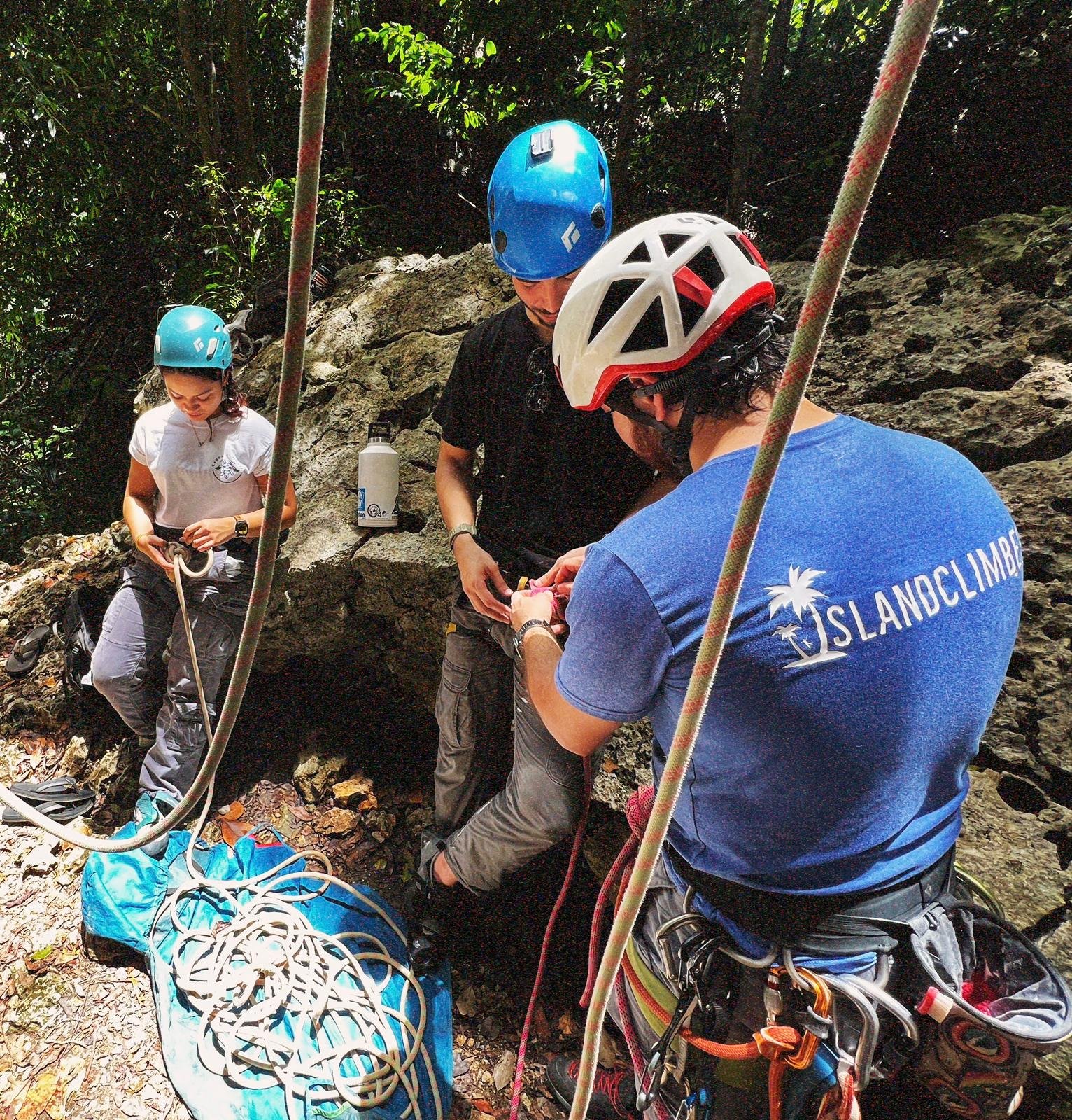Mastering the Art of Climbing Knots: A Guide for Adventurous Explorers
Imagine standing on the edge of a precipice, ready to embark on an exhilarating rock-climbing journey. As you gear up, securing your knots is crucial to your preparation. Climbing knots are the lifelines that connect climbers to their ropes, anchors, and each other. This comprehensive guide will delve into climbing knots, exploring their importance, different types, and how to tie them effectively. Understanding and mastering these knots is essential for a safe and successful climbing experience, whether you are a beginner or a seasoned climber.
Our Instructor Carlos rappelling from a classic route called “The Nose” at “Cerro Las Tetas” in Cayey, PR
I. The Importance of Climbing Knots
Before we explore the various knots, it's essential to understand why they hold such significance in climbing. Climbing knots serve multiple purposes:
Safety: Climbing knots provide the fundamental basis of protection in the vertical realm. They keep climbers securely connected to ropes and anchors, preventing falls and ensuring stability during ascents and descents.
Load Distribution: Properly tied knots distribute the load across the rope, minimizing stress on individual sections and enhancing overall strength. This is crucial for maintaining the system's integrity and reducing the risk of rope failure.
Communication: Knots serve as a language of communication among climbers. Different knots convey specific messages and intentions, allowing seamless coordination and collaboration during multi-pitch climbs or rescue scenarios.
II. Essential Climbing Knots
Now let's explore some of the essential knots that every climber should be familiar with:
Figure-Eight Knot: The figure-eight knot is the foundation of many climbing knots. It creates a secure loop at the end of a rope, used for tying in, attaching to anchors, and creating stopper knots.
Example of a Figure Eight Knot:
Figure-Eight Follow-Through: This knot is commonly used for tying into a harness. It provides a robust and reliable connection between the climber and the rope, with an easily recognizable and inspectable structure. To check if the knot is correct, count the number of pairs of strands in the figure-eight shape - there should be five pairs and ten strands.
Check out these excellent examples, presented from left to right!
Clove Hitch: The clove hitch is a versatile knot for securing ropes to carabiners or other anchor points. It's quick to tie and untie, making it ideal for creating temporary anchor systems. We recommend using pear-shaped or HMS carabiners for optimal effectiveness and safety when tying this knot. To ensure extra security, we suggest using a locking carabiner.
Check out these excellent examples, presented from left to right!
Munter Hitch: The Munter hitch is a versatile knot that is a belay and rappel device. It's handy in emergencies when standard equipment may not be available. Make sure it's done with a locking pear-shaped or HMS carabiner to make it more effective and safer. Also, it can make your rope fuzzy, so flake it afterward.
Check out these excellent examples, presented from left to right!
Prusik Knot: The prusik knot is an invaluable tool for ascending or descending ropes. It grips the main rope when weighted but slides smoothly when unweighted, allowing climbers to maneuver on fixed lines safely. For example, when rappelling, a prusik acts like a secondhand to break if you let go of the rope on a descent.
Check out these excellent examples, presented from left to right!
Double Fisherman's Knot: The double fisherman's knot is commonly used for joining two ropes. It creates a secure and reliable bond that minimizes bulk and avoids snagging. It is also a good stopper knot for closing the system on the other end of the rope to prevent accidents.
Check out these excellent examples, presented from left to right!
The water knot, or the tape knot, joins webbing or slings. It creates a flat and compact knot that maintains strength and stability. It's beneficial for tying webbing or slings around objects or trees, but it might be challenging to untie once weighted.
Check out these excellent examples, presented from left to right!
III. Mastering the Art of Knot Tying
Tying climbing knots effectively requires practice, precision, and attention to detail. Here are some essential tips to keep in mind:
Familiarize Yourself: Study the knots through visual resources, diagrams, and instructional videos. Understanding their structures and purposes is crucial before attempting to tie them.
Practice Makes Perfect: Regularly practice tying knots in a controlled environment, such as your backyard or a climbing gym. Repetition builds muscle memory and ensures you can tie knots confidently and efficiently, even in stressful situations.
Check and Double Check: Always inspect your knots and those of your climbing partners before embarking on any ascent. Verify they are properly tied, dressed, and secured, leaving no room for uncertainty.
Seek Guidance: If you're a beginner or uncertain about a specific knot, seek guidance from experienced climbers or consider enrolling in a climbing lesson or workshop. Professional instruction can provide valuable insights and feedback to enhance your knot-tying skills.
Conclusion:
As climbers, we rely on the strength and reliability of our knots to keep us safe and connected to the vertical world. By understanding the importance of climbing knots, learning the essential types, and mastering their proper techniques, we empower ourselves with the knowledge and skills necessary for successful ascents and descents. So, whether you're a beginner seeking to explore the world of climbing or an experienced climber aiming to refine your skills, take the time to study and practice these knots. Safety is paramount in climbing, and mastering knots is crucial to becoming a confident and proficient climber.
Ready to take your climbing skills to new heights? Book a climbing lesson with our experienced and certified instructors today. Whether you're a novice or an experienced climber, our personalized coaching will help you improve your technique, master essential knots, and elevate your climbing prowess. Visit our website or contact us now to embark on an unforgettable climbing journey. Start your adventure today!































